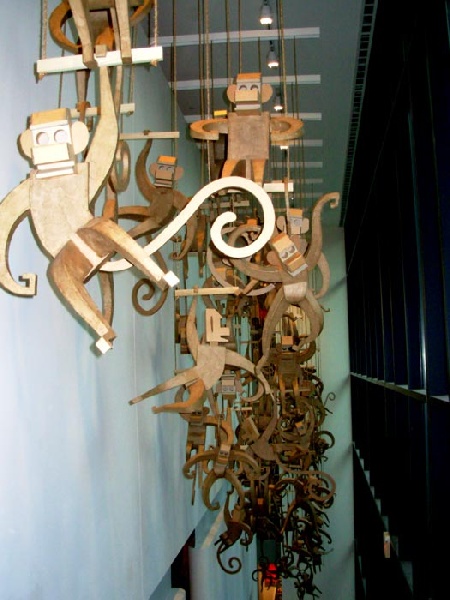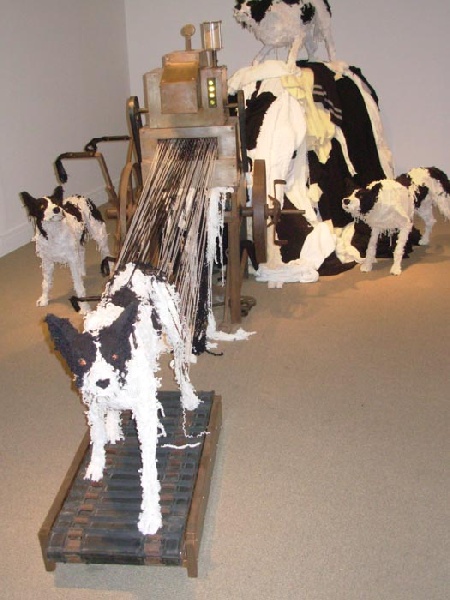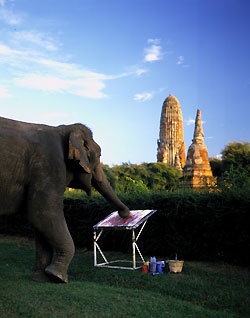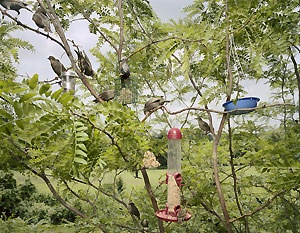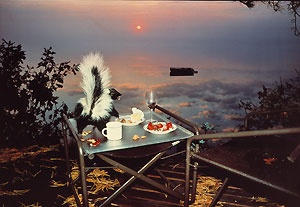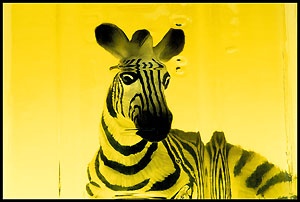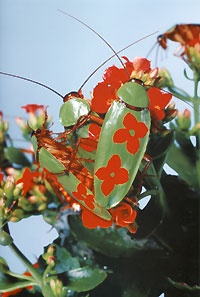It's a Jungle at the DeCordova
Monkey See Monkey Do
By: Charles Giuliano - Sep 19, 2006
The Artists: Deborah Brown, Catherine Chalmers, Walton Ford, James Grashow, John Harden, Henry Horenstein, Mary Kenny, Komar & Melamid, Neeta Madahar, Barbara Moody, Josie Morway, Gwynn Murrill, Frank Noelker, Barbara Norfleet, Shelly Reed. Amy Ross, Peter Smuts, Brad Story and Kitty Wales DeCordova Museum and Sculpture Park,
Lincoln, Mass.
September 2 through January 7
The current group show "Going Ape: Confronting Animals in Contemporary Art" on view at the DeCordova Museum and Sculpture Park in posh Lincoln, Mass. through January 7, 2007, is, well, more fun than a barrel of monkeys. Sortah. There seems to be a domino effect of creature feature exhibitions in New England museums. First came Mass MoCA last year with the ambitious "Being Animal." This summer the Berkshire Museum in Pittsfield mounted the popular and lively "Bug Out of the Box" through October 29, 2006. A connecting thread in these shows seems to be including the insect based, large format, color photographs of Catherine Chalmers.
To some extent these and other non human themed exhibitions appear to be curatorial strategies to show contemporary work that relates to and engages audiences in a lively dialogue providing an educational and aesthetic experience with populist appeal and a minimum of risk taking. Everyone from the director and board, to the curators and exhibiting artists, strive to create exhibitions and make work that is fun for the whole family. For all involved particularly the general public these shows are win win ventures which as a marketing strategy and agenda to build audiences and expand demographics makes perfect sense. As long as museums and curators balance the equation by risk taking in presenting complex and challenging work. Why not mix and match to create diverse and effective programming.
Judging from the tepid critical responses, however, by art scribes assigned to cover these midbrow exhibitions there may be too much of a good thing. The most repeated word in the Phoenix review by Christopher Millis is "cute." Frankly I like my visual shots straight no chaser. Nothing like a good, tough, bracing belt of art to get the juices flowing. So how to sink your teeth into an exhibition in which you walk around with a smiley face? Where's the challenge in that.
But let's take a step back and consider that in addition to Chalmers there are a number of contemporary artists (here mostly gathered in New England) who choose to do animal or insect themed work. I don't entirely think it is just about dumbing down the work or trolling for sales to upscale suburban collectors. As "Being Animal" demonstrated an artist can touch on this material while still creating tough, cutting edge work. Actually, there was work in this show that I truly respect and enjoy. As well as a good portion which is, ho hum.
It's older work but always delightful to view once again a remarkable series of images by Barbara Norfleet. She hung out in her car in the forest and startled an array of animals and rodents that landed momentarily on her windshield. In a similar strategy the British artist, who studied at the Museum School, Neeta Madahar staked out birds visiting a feeder viewed from a window in her home. This resulted in the series of large format digital prints in the "Sustenance" series which she has shown internationally with great success. I had heard of but never actually seen the collaborations between the Russian born team of Komar & Melamid who induced an elephant into making rather remarkable abstract expressionist paintings. You would swear that Jumbo went to art school. But there are serious issues of exploitation as the resultant works sell for big bucks and the elephant is working for peanuts. So it seems.
There is a swarm of monkeys swinging down the main staircase of the museum by James Grashow. It's all fun, fun, fun till Daddy takes the T Bird away. Or something like that. Henry Horenstein has written several of the most used, how to, photo darkroom books. But truth is his perfectly printed, black and white images are academic and boring. Shelly Reed channels old masters with her grisaille appropriations. Peter Smuts is pretty funny and Amy Ross is everywhere. Kitty Wales always tries hard. Here showing a group of howling black and white life size, freed standing dogs. Woof. There were several other artists.
Yes this show did put a smile on my face. But it wore off quickly. One reason to see this show might be to enjoy the fall foliage along bucolic Trapelo Road. Getting there may be half the fun. As in fun, fun, fun. Excuse me, I need a stiff one.

